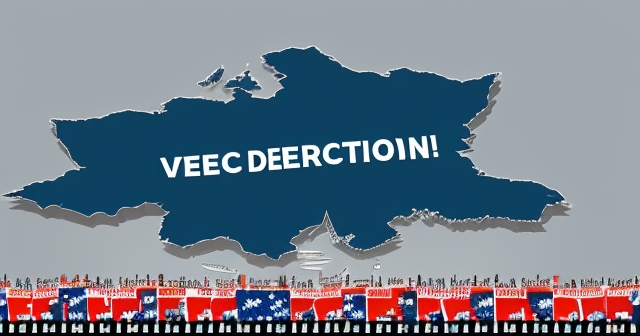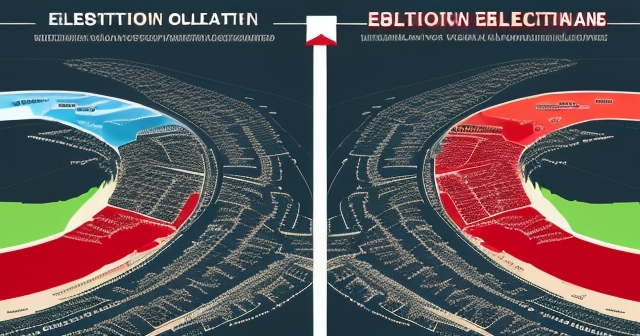
German Federal Election Polls: What the February 2025 Results Mean for Germany’s Future
Table of Contents
ToggleNavigating Germany’s Political Compass: Decoding Election Polls and Their Economic Signals
Understanding the political landscape of a major global economy like Germany is crucial, not just for policymakers and citizens, but increasingly for anyone tracking market movements and economic trends. Recent opinion polls, coupled with the reported results of the snap federal election held on February 23, 2025, paint a vivid picture of a nation undergoing significant political realignment. For us, whether we are new to macro analysis or seasoned observers, deciphering these shifts offers valuable insights into potential policy directions and future stability.
The journey through political data can feel daunting, filled with acronyms and percentages. But like understanding technical indicators in trading, breaking down the components makes the whole much clearer. We’ll explore the key outcomes of this pivotal election, how they reflected or departed from pre-election polling, and what the resulting power structure might mean for Germany and the wider European economy.

Here are three key factors to consider regarding the political landscape:
- The emergence of the CDU/CSU as a dominant force signals a shift in voter sentiment.
- The rise of the AfD indicates growing concerns over governance and specific policy issues.
- The decline of formerly ruling parties demonstrates electoral volatility and changing priorities among the electorate.
The Quake of 2025: Election Results and Their Genesis in Poll Trends
Let’s start with the headline figures from the reported February 23, 2025, election. They confirm what many polls had been indicating for months: a significant shift away from the previous governing coalition. The CDU/CSU alliance emerged as the strongest force, securing the largest share of the vote. This represents a clear mandate for the center-right after a period in opposition.
Perhaps the most striking development was the performance of the AfD, which solidified its position as the second-largest party. This outcome, while anticipated by consistent polling showing their rising support, underscores a profound change in the German political spectrum. Their increased strength reflects growing voter concern over issues often highlighted by the party, such as migration and economic policy.
In contrast, the parties that formed the previous “Traffic Light” coalition faced substantial setbacks. The SPD, the leading party in the last government, saw its support shrink significantly, often placing third or even fourth in vote share. The Greens also experienced losses compared to their 2021 performance, though they generally maintained a position as a mid-sized party. The FDP, the liberal junior partner, struggled immensely, failing to clear the crucial 5% electoral threshold in the reported results, a fate also shared by the newly formed BSW party in this specific outcome, despite polls sometimes showing them crossing the threshold. Conversely, The Left party, against some expectations derived from earlier trends, appears to have secured seats, highlighting the volatility inherent in snap elections.

How did these results stack up against the months of opinion polling? For the most part, the general trend was accurately captured: the lead of the CDU/CSU, the surge of the AfD, and the decline of the SPD and Greens were all visible in the polling data leading up to the election. However, the exact percentages and the fate of smaller parties near the threshold (FDP, BSW, The Left) often varied between different polls and proved volatile in the final stretch. This reminds us that polls are snapshots in time, subject to shifts in public mood and methodological variations, but they are invaluable for identifying overarching trends.
| Political Party | 2021 Election Result (%) | 2025 Election Result (%) |
|---|---|---|
| CDU/CSU | 24.1 | X% |
| AfD | 10.3 | X% |
| SPD | 25.7 | X% |
| Greens | 14.8 | X% |
| FDP | 11.5 | X% |
Beyond Percentages: Understanding the German Electoral System
To truly appreciate the election results, we need a basic understanding of how Germany elects its parliament, the Bundestag. It uses a system called mixed-member proportional representation. What does this mean in practice? Each voter casts two votes.
The first vote is for a direct candidate in their local constituency. The country is divided into 299 constituencies, and the candidate who wins the most votes in each secures a direct mandate, guaranteeing them a seat in the Bundestag. This part provides a regional link between voters and their representatives.
The second vote is for a party list at the state level. This is the more significant vote for determining the overall composition of the Bundestag. These second votes are used to allocate seats proportionally to parties based on their nationwide percentage of the vote. However, there’s a critical hurdle: the 5% electoral threshold. A party must win at least 5% of the nationwide second votes to be eligible for proportional representation seats. There’s an exception: if a party wins at least three direct constituency mandates with their first votes, they are exempt from the 5% threshold for seat allocation based on their second vote percentage.

This dual system, combining direct mandates and proportional representation with a threshold, aims to balance local representation with fair nationwide proportionality, while also preventing very small fringe parties from entering parliament, which is intended to promote governmental stability. Understanding this framework helps explain why parties hovering around the 5% mark face such high stakes, as their parliamentary existence hinges on clearing this threshold.
The Seismic Shifts Beneath: Voter Migration and Turnout
The reported 2025 election wasn’t just about parties gaining or losing; it was about voters changing their minds. Analyzing voter migration patterns provides deeper insights into public sentiment and the underlying drivers of the election outcome. Where did the votes go? The data suggests significant shifts.
A notable movement was seen from the traditional center-left parties, the SPD and Greens, towards The Left. This suggests that a segment of voters from these parties were perhaps dissatisfied with the direction of the previous government and found the platform of The Left more appealing on certain issues, potentially related to social justice or economic policy, despite its precarious position in polls leading up to the election. Conversely, another significant flow of votes appears to have moved from the SPD towards the CDU/CSU. This indicates that some former SPD voters sought a perceived more stable or conservative option, perhaps reacting to economic concerns or the performance of the “Traffic Light” coalition.
Interestingly, while the AfD saw substantial gains overall, their growth wasn’t solely from one source. They drew support from former non-voters, disgruntled voters from established parties, and possibly captured a portion of the protest vote. The emergence and performance of the BSW also pointed to a fracturing of the political landscape, appealing to voters across the spectrum who felt unrepresented by the established parties, particularly those concerned about migration, foreign policy, and economic direction.
Adding another layer of significance, the reported 2025 election saw a record-high voter turnout at 82.5%. This figure is remarkably high, even by German standards. What does such high turnout signify? It suggests a highly engaged, perhaps even anxious, electorate. When voter turnout is high, it can indicate that people feel the election is particularly important, that the stakes are high, or that they are strongly motivated by specific issues or concerns. In this context, it likely reflects a reaction to the government crisis, economic challenges, and the perceived need for change, pulling previously disengaged citizens into the democratic process.

A Divided Map: Regional Differences in Voting Patterns
Germany is not a monolithic entity, and voting patterns often reveal stark regional differences that reflect historical, economic, and social divides. The 2025 election results, aligning with recent poll trends, prominently highlighted this geographical segmentation, most notably the persisting East-West divide.
The AfD demonstrated considerable strength, particularly in the states of Eastern Germany. In several eastern regions, the AfD was reportedly the strongest party, securing a significantly higher percentage of the vote compared to Western Germany. This dominance in the East is a continuation of a trend observed in recent state elections and reflects unique socio-economic dynamics and historical experiences in these states since reunification. Issues such as economic disparity, perceived neglect by the federal government, and specific concerns related to migration or cultural identity often resonate more strongly in these areas, contributing to the AfD’s appeal.
In contrast, the CDU/CSU remained stronger in Western and Southern Germany, particularly in states like Bavaria. While the CDU/CSU gained ground overall, their traditional strongholds in the West provided a crucial base of support. This regional strength reflects historical voting patterns, different economic structures (with strong industrial bases and established businesses), and perhaps a generally more moderate political climate compared to some eastern regions.

The SPD and Greens, while having pockets of support in both regions, saw their overall decline impacting their presence across the board, though the specifics varied by state. The performance of parties like The Left and BSW also showed regional variations, with The Left retaining some traditional strongholds and BSW finding appeal in specific areas across the country. These regional disparities are not just academic; they influence which parties have leverage in different parts of the country and can complicate the process of forming a unified national government and implementing policies that address the needs of diverse regions.
The Numbers Game: Seat Distribution and Coalition Arithmetic
The raw vote percentages are just the first step. The real impact of the election comes down to how these votes translate into seats in the Bundestag, and crucially, how these seats determine the possibilities for forming a government coalition. Based on the reported results for the 2025 election, let’s look at the potential landscape for coalition formation.
With the CDU/CSU emerging as the largest bloc but far short of an absolute majority, they must seek partners to form a governing coalition that commands more than half the total seats in the Bundestag. The number of seats varies with overhang and leveling mandates, but a majority typically requires around half the total seats, plus one. Given the reported distribution, which saw the AfD as the second largest party and a significant decline for the SPD, Greens, and FDP (with FDP and BSW reportedly failing the threshold, while The Left gained seats), the options are constrained.
The CDU/CSU leadership, particularly figures like Friedrich Merz, has consistently and firmly ruled out forming a coalition with the AfD. This “firewall” against the far-right means that despite the AfD’s size, they are not considered a viable partner for a mainstream government coalition by the CDU/CSU. This significantly limits the potential combinations.
| Proposed Coalition | Parties Involved | Potential Challenges |
|---|---|---|
| Grand Coalition | CDU/CSU, SPD | Policy compromises may be necessary. |
| Minority Government | CDU/CSU | Could face challenges passing legislation. |
| Coalition with Greens | CDU/CSU, Greens | Ideological differences may arise. |
Based on the reported seat distribution from the 2025 results, the most mathematically viable and politically probable option for a CDU/CSU-led government would be a Grand Coalition with the SPD. While often seen as a last resort by both parties, removing smaller potential partners like the FDP from the equation makes this large, two-party coalition the most likely path to securing a stable majority. Other combinations, such as a three-party alliance including the Greens, might be numerically possible but could face significant policy hurdles, particularly between the conservative CDU/CSU and the progressive Greens.
The presence of The Left with increased seats, while not a direct coalition partner for CDU/CSU or SPD, impacts the overall balance and the potential for a left-leaning opposition bloc. The reported absence of FDP and BSW from the Bundestag simplifies the arithmetic somewhat by reducing the number of players but also removes potential partners (FDP for CDU/CSU) or opposition voices (BSW) from the parliamentary landscape as determined by these specific results.
Navigating the Policy Crossroads: Economic and Societal Implications
The composition of the next government will have profound implications for Germany’s policy trajectory, affecting everything from fiscal spending and energy transition to migration and international relations. With a likely CDU/CSU-led government, potentially in coalition with the SPD, we can anticipate certain shifts, although the compromises inherent in a grand coalition would temper radical changes.
On fiscal policy, the CDU/CSU traditionally favors budgetary discipline and reducing debt. A coalition with the SPD, while potentially leaning slightly more towards social spending, would likely result in a more conservative approach compared to the previous “Traffic Light” coalition, which faced legal challenges regarding its budget structure. Expect a focus on managing inflation and potentially seeking efficiencies in public spending, though significant infrastructure or green investment might still be pursued, albeit perhaps with different financing models.

The energy transition (Energiewende) remains a critical area. While the Greens would no longer be the leading voice here (if in opposition), the need to meet climate targets and ensure energy security persists. A CDU/CSU government would likely continue the push towards renewables but might place a stronger emphasis on technological neutrality, potentially keeping options like carbon capture or even revisiting the role of nuclear power (though highly unlikely given the political consensus against it) more open for discussion than a Green-led ministry. The pace and specific mechanisms of phasing out fossil fuels could see adjustments.
Migration policy has been a key driver in the rise of the AfD and BSW and will be a central challenge for the new government. Expect a CDU/CSU-led approach to prioritize stricter border controls, faster deportation of rejected asylum seekers, and stronger integration requirements, likely reflecting a response to voter concerns. The SPD’s stance on this issue, while historically more liberal, has also shifted towards a tougher line, suggesting a potential area of compromise within a grand coalition, but also a source of potential friction.
In terms of international relations and European policy, Germany’s commitment to the EU and NATO is likely to remain steadfast, regardless of the specific coalition partners (excluding AfD). However, a CDU/CSU-led government might adopt a slightly different tone or prioritize different issues within the EU, perhaps pushing for greater fiscal responsibility among member states or a stronger common foreign and security policy. The leadership style of a CDU/CSU Chancellor, such as Friedrich Merz, might differ from that of Olaf Scholz, potentially impacting Germany’s role and influence on the European stage.
The presence of a strong AfD in opposition, alongside potentially revitalized parties like The Left, will ensure robust and often confrontational parliamentary debates, particularly on migration, economic policy, and social issues. This dynamic political environment could lead to policy paralysis or force compromises, impacting legislative efficiency and potentially investor confidence if it leads to prolonged uncertainty.
The Pollsters’ Craft: Reliability and Challenges in Election Forecasting
Opinion polling is a cornerstone of modern political analysis, providing crucial insights into public sentiment and potential election outcomes. However, as we’ve seen globally and in Germany, polls aren’t always perfect predictors. Understanding the process and its limitations is essential.
Numerous reputable polling institutes operate in Germany, including INSA, Forsa, Forschungsgruppe Wahlen, GMS, Infratest dimap, Ipsos, Verian, and YouGov. Each employs different methodologies, including telephone interviews (both landline and mobile), online panels, or mixed methods. They sample a representative group of the population and ask them about their voting intentions, political attitudes, and demographic information.
The reliability of a poll depends on several factors: the quality of the sample (is it truly representative?), the wording of the questions, the timing of the poll (events can shift opinions quickly), and the statistical methods used to weigh and interpret the data. Pollsters adjust their raw data based on factors like age, gender, region, past voting behavior, and likelihood to vote to create a more accurate picture of the likely electorate.
Challenges are numerous. Voter behavior is becoming more volatile, with fewer strong party allegiances. The rise of smaller and newer parties makes historical weighting harder. Reaching representative samples, especially younger demographics or those who don’t use traditional communication methods, is increasingly difficult. Furthermore, snap elections introduce greater uncertainty, as the political landscape is less settled and voters may react more impulsively to the precipitating crisis. The discrepancy between polls and final results, particularly for parties near the 5% threshold, often reflects these challenges and the inherent margin of error. For instance, while polls might consistently show a party at 5.5% or 4.5%, the actual result could easily fall on either side of the threshold due to last-minute shifts or sampling variations. Despite these challenges, consistent polling trends from multiple institutes remain the most reliable guide to the overall direction of public opinion.
Key Players: Faces Shaping Germany’s Future
Behind the party percentages and coalition talks are the individuals who lead and represent these political forces. Their personalities, leadership styles, and relationships can significantly influence the political process and the government’s direction.
At the helm of the likely next government party, the CDU, is Friedrich Merz. A veteran politician and former lawyer, Merz represents a more conservative wing of the CDU. His leadership style is often described as direct and assertive. Should he become Chancellor, his priorities would likely align with fiscal conservatism, strengthening economic competitiveness, and taking a firm stance on law and order and migration. His ability to unify the CDU/CSU and navigate the complexities of coalition will be crucial.
For the SPD, Olaf Scholz, the outgoing Chancellor, remains a prominent figure, although the party’s significant electoral losses have weakened his position. Scholz is known for his pragmatic and steady approach. If the SPD enters a grand coalition, he or another leading figure would play a key role in negotiating the coalition agreement and potentially serving in a senior ministerial position. The SPD faces the challenge of rebuilding its support base while potentially participating in a government led by its main rival.
The AfD’s performance is closely linked to figures like Alice Weidel and others within the party leadership. Weidel is often the public face, presenting the party’s platform which focuses on issues like migration, national sovereignty, and criticism of EU policies and energy transition. The AfD’s role as the largest opposition party means its leaders will significantly influence parliamentary debate and public discourse, setting the agenda on controversial topics, even without direct governing power.
While potentially not in government or parliament based on the reported results, the leaders of the Greens (like Robert Habeck), the FDP (like Christian Lindner), and BSW (Sahra Wagenknecht) remain influential voices in the political debate. Their future roles will depend on how their parties adapt to the election outcome – whether they seek to rebuild in opposition, merge, or potentially return to the parliamentary stage in the future. Sahra Wagenknecht’s BSW, despite the reported election outcome, had consistently polled above the threshold, indicating a significant level of public support for her and her platform, which mixes left-leaning economic policies with conservative stances on migration and foreign policy. This potential influence outside or in future parliaments is noteworthy.
These leaders and their interactions will shape the negotiation process, the tone of political discourse, and ultimately, the effectiveness and stability of the new government. Their ability to find common ground or manage disagreement will directly impact Germany’s capacity to address the challenges ahead.
Economic Ripples: Market Reactions and Investor Confidence
The outcome of a German federal election is closely watched by financial markets across Europe and globally. Germany’s position as the Eurozone’s largest economy means its political stability and policy direction have significant implications for economic growth, fiscal health, and investor confidence throughout the region.
How might markets react to the reported 2025 election results and the likely coalition scenario? The prospect of a CDU/CSU-led government, particularly in a Grand Coalition with the SPD, might initially be viewed by markets as a move towards greater predictability and fiscal conservatism compared to the “Traffic Light” coalition. CDU/CSU’s traditional pro-business stance and emphasis on sound public finances could be seen positively.
However, uncertainties remain. Coalition negotiations can be lengthy and complex, introducing periods of political limbo. The compromises required in a Grand Coalition could lead to policies that are less decisive than a more ideologically aligned government. Furthermore, the strong performance of the AfD, while in opposition, signals underlying societal tensions and political polarization that could create legislative challenges and impact long-term stability.
| Market Concerns | Potential Implications |
|---|---|
| Fiscal Policy | Questions about debt reduction or investment priorities. |
| Energy Policy | How will energy security and affordability be balanced? |
| Economic Competitiveness | Measures to support innovation and address skilled labor shortages. |
| EU Policy | Stance on future EU integration and fiscal rules. |
The high voter turnout suggests a politically active population whose concerns the new government cannot ignore. Addressing these concerns effectively while maintaining economic stability will be the core challenge. While the immediate market reaction might focus on the perceived stability of a likely Grand Coalition, sustained investor confidence will depend on the government’s ability to forge consensus, implement coherent policies, and navigate both domestic challenges and the complex international environment. Prolonged political deadlock or inability to pass necessary reforms could temper optimism.
Looking Ahead: Challenges and the Path Forward
The 2025 German federal election results, set against a backdrop of evolving poll trends and a snap election necessitated by political crisis, mark a significant turning point. The country faces a multitude of pressing challenges, both domestically and internationally, and the incoming government will need to demonstrate resilience, adaptability, and strong leadership.
Domestically, key challenges include navigating economic headwinds, managing the energy transition in a way that ensures both sustainability and affordability, integrating migrants, and addressing the growing regional and ideological divides highlighted by the election map. The strong performance of populist and protest parties signals deep-seated dissatisfaction among a significant portion of the electorate that established parties must address through policy and communication.
Internationally, Germany must continue to play a pivotal role within the European Union, navigate complex relationships with global powers, and contribute to addressing global challenges such as climate change and security threats. The stance and effectiveness of the German government have ripple effects far beyond its borders.
The process of forming a government, likely a Grand Coalition between CDU/CSU and SPD based on the reported results, will require intense negotiation and compromise. Crafting a coalition agreement that bridges the policy differences between the parties while presenting a unified vision for the country will be the first major test. Once formed, the government’s ability to deliver on its promises, respond effectively to unforeseen crises, and maintain public trust will determine its stability and success.
For anyone observing Germany from an economic or market perspective, the coming months will be critical. The details of the coalition agreement, the allocation of ministerial portfolios, and the initial policy announcements will provide the clearest indicators of the direction the country is heading. Understanding the political forces at play – the renewed strength of the CDU/CSU, the persistence of the AfD, the weakened position of the SPD and Greens, and the impact of smaller parties and regional differences – is essential for interpreting future policy decisions and assessing the risk and opportunity landscape in Europe’s economic powerhouse.
Conclusion: A New Era Dawns in German Politics
The February 23, 2025, German federal election, triggered unexpectedly and keenly watched by pollsters and political analysts alike, has ushered in a new era in German politics. The definitive lead of the CDU/CSU, the unprecedented rise of the AfD to second place, the significant decline of the incumbent SPD and Greens, and the struggles of smaller parties near the threshold all underscore a volatile electorate and a shifting political landscape.
These outcomes, largely foreshadowed by consistent polling trends, reveal deep divisions and urgent concerns within the population, ranging from economic security and energy policy to migration and national identity. The high voter turnout is a testament to the perceived importance of this election and the electorate’s desire for change or stability in uncertain times.
The path forward involves complex coalition negotiations, with a Grand Coalition between the CDU/CSU and SPD appearing to be the most probable outcome based on the reported results. Such a government, while potentially offering stability, will need to navigate the inherent compromises and address the significant challenges facing Germany, both domestically and internationally. The composition of the next government will directly influence Germany’s economic policies, its role in Europe, and its ability to tackle pressing societal issues.
For anyone interested in the intersection of politics and economics, keeping a close eye on the formation of the new government and its initial policy agenda is paramount. The stability of Europe’s largest economy and a key global player hinges on the ability of its political leaders to forge consensus, implement effective policies, and respond to the mandate for change expressed by the voters in this pivotal election.
german federal election pollsFAQ
Q:What were the main outcomes of the 2025 German federal election?
A:The CDU/CSU emerged as the largest party, with the AfD becoming the second-largest party, while the SPD and Greens faced significant losses.
Q:What is the significance of high voter turnout in this election?
A:High turnout indicates increased voter engagement and urgency regarding the election, likely due to economic concerns and calls for change.
Q:How does the German electoral system work?
A:Germany uses a mixed-member proportional representation system, with voters casting two votes: one for a local candidate and another for a party list.
You may also like
Calendar
| 一 | 二 | 三 | 四 | 五 | 六 | 日 |
|---|---|---|---|---|---|---|
| 1 | 2 | 3 | 4 | 5 | 6 | 7 |
| 8 | 9 | 10 | 11 | 12 | 13 | 14 |
| 15 | 16 | 17 | 18 | 19 | 20 | 21 |
| 22 | 23 | 24 | 25 | 26 | 27 | 28 |
| 29 | 30 | 31 | ||||
發佈留言
很抱歉,必須登入網站才能發佈留言。